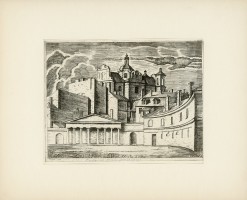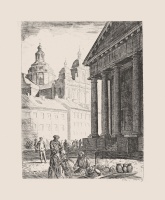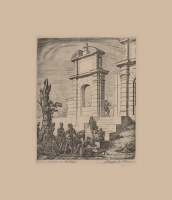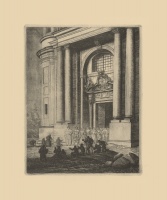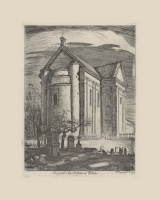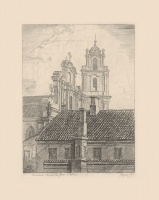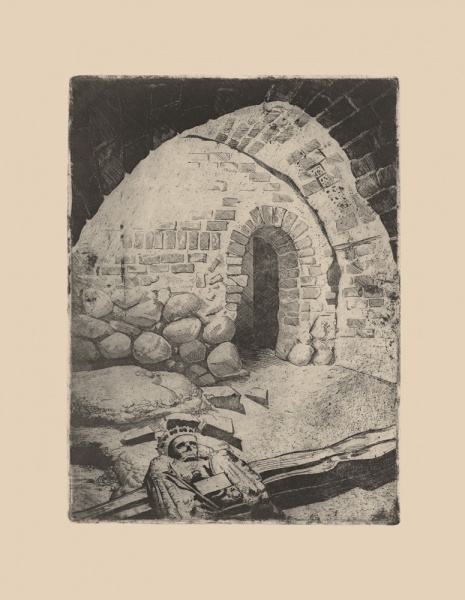

The remains of Barbara Radziwiłł in the cathedral
| Author: |
Jerzy Hoppen (1891–1969)  |
| Created: | 1933 |
| Material: | paper |
| Technique: | etching |
| Dimensions: | 41 × 31 cm |
| Signature: | unsigned |
During the work to minimise the effects of the 1931 flood, the most sensational historical discovery of the period was made in the foundations of the Cathedral. A crypt was found on 24 September 1931 under the central nave, with the remains of King Alexander Jagiełłon and the two wives of Sigismund Augustus, Elisabeth and Barbara Radziwiłł. Several famous Vilnius artists, such as Ferdynand Ruszczyc, Ludomir Sleńdziński and Kazimierz Kwiatkowski, immortalised the discovery in their work. Hoppen made an engraving of the somewhat macabre sight in the crypt: the remains of the famous Queen Barbara, with a crown, a sceptre, a golden apple with a cross, and a silver insignia. A royal mausoleum with sarcophagi was created in the crypt in 1939.
Text author Laima Laučkaitė
Not only was Vilnius Cathedral the most important church in the diocese and the capital of the Grand Duchy of Lithuania, it was also a pantheon of prominent nobles who served the state. Thus, the cathedral performed partly a religious and partly a political function. As early as 1535, at the initiative of Queen Bona Sforza, a marble monument to Vytautas was put up there (it was probably destroyed in the 17th century when Moscow’s troops seized Vilnius). In 1930, the 500th anniversary of the death of Vytautas the Great, there were hopes that his remains might be found in the crypt of the cathedral. Although a search did not produce any results, it revealed the poor condition of the foundations and the walls of the building. Preparatory repair work started, and was extended after the flood of 1931.
Despite causing a great deal of damage, the flooded Neris also brought good news for the people of Vilnius. During the work, the remains of members of the royal family, including Barbara Radziwiłł, were discovered. This was another reason to look back at history, and to consolidate the image of Vilnius as the capital and as a royal city.
In the interest of safety, and to respect the sacred nature of the site, the Royal Crypt and its relics were not accessible to the public, so works of art and photographs that captured this extraordinary discovery were exceptionally important. Images of the finds were published in the press, and prints of them were made. Travelling exhibitions were held in Vilnius and Warsaw. One of the artists entrusted with recording the research on the crypt was Jerzy Hoppen (1891–1969). He depicted both the royal remains and the repair work on the cathedral in his etchings.
Text authors Dovilė Barcytė and Ieva Burbaitė
Source: Law firm Valiunas Ellex art album VILNIUS. TOPOPHILIA II (2015). Compiler and author Laima Laučkaitė, KAUNAS–VILNIUS / 1918–1945 (2021). Compilers and text authors Dovilė Barcytė and Ieva BurbaitėExpositions: "1918-1945 / Kaunas-Vilnius", 27 August 2020 – 21 August 2021, Lithuanian Art Centre TARTLE (Užupio St. 40, Vilnius). Curators Dovilė Barcytė and Ieva Burbaitė.







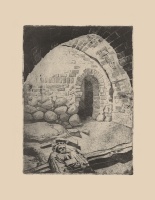
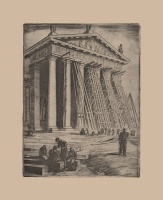
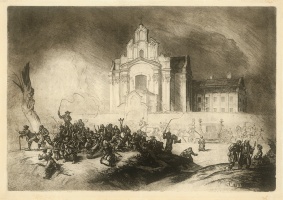
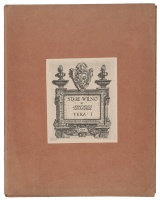
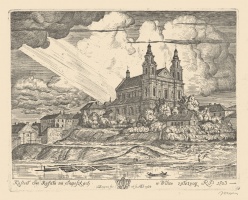
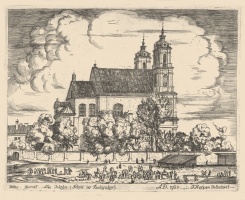
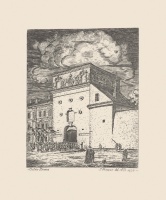
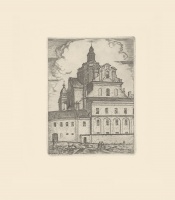
.jpg)
.jpg)
.jpg)
.jpg)
.jpg)
